Community Microgrid Scheduling Considering Network Operational Constraints and Building Thermal Dynamics †
Abstract
:1. Introduction
- A multi-objective optimization model is proposed to optimize both the operating cost and performance indices of a microgrid. The analytical hierarchy process (AHP) has been introduce to calculate the weighting coefficients of different objectives [31].
- The building thermal dynamics and HVAC controllers have been integrated into the microgrid scheduling model. The HVAC systems are directly scheduled by the microgrid controller and the operating cost are reduced significantly; and
- The proposed model has been validated in various simulation cases.
2. System Modeling
2.1. Community Microgrid Model
2.2. HVAC System Model
2.3. Building Thermal Dynamic Model
3. Problem Formulation
3.1. Objective
3.2. Constraints
3.2.1. Constraints of DGs
3.2.2. Constraints of Energy Sotrage
3.2.3. Load Constraints
3.2.4. Network Constraints
3.2.5. Constraints at PCC
3.3. Simplification and Linearization
4. Case Studies
4.1. Effect of Weighting Factors
4.2. Comparison of Cost between Different Control Methods
- Case 1: Autonomous temperature control in grid-connected mode.
- Case 2: Proposed optimization in grid-connected mode.
- Case 3: Autonomous temperature control in islanded mode.
- Case 4: Proposed optimization in islanded mode.
4.3. Operation in Grid-Connected Mode
4.4. Operation in Islanded Mode
5. Conclusions
Acknowledgments
Author Contributions
Conflicts of Interest
Nomenclature
| Indices and Sets | |
| i | Index of DGs, running from 1 to . |
| b | Index of batteries, running from 1 to . |
| h | Index of houses, running from 1 to . |
| v | Index of PV generation, running from 1 to . |
| f | Index of feeders, running from 1 to . |
| n | Index of buses, running from 1 to . |
| t | Index of time periods, running from 1 to . |
| m | Index of energy blocks offered by DGs, running from 1 to . |
| Sets of DGs connected at bus n. | |
| Sets of batteries connected at bus n. | |
| Sets of houses connected at bus n. | |
| Sets of PV connected at bus n. | |
| Sets of feeders. | |
| Variables | |
| Binary Variables | |
| 1 if DG i is scheduled on during period t and 0 otherwise. | |
| 1 if HVAC of house h is scheduled cooling/heating during period t and 0 otherwise. | |
| 1 if battery b is scheduled charging/discharging during period t and 0 otherwise. | |
| Continuous Variables | |
| Power output scheduled from the m-th block of energy offer by DG i during period t. Limited to . | |
| Real/reactive power output scheduled from DG i during period t. | |
| Charging/discharging power of battery b during period t. | |
| Reactive power of battery b during period t. | |
| State of charge of battery b during period t. | |
| Real/ reactive power at PCC during period t. | |
| Real/reactive load of house h during period t. | |
| Real/reactive load curtailment of house h during period t. | |
| Indoor temperature of house h during period t. | |
| The temperature of thermal accumlating layer of inner walls and floor in house h during period t. | |
| The temperature of house envelop during period t. | |
| Voltage magnitude of bus n during period t. | |
| Real/ reactive power flow on line f during period t. | |
| Squared amplitudes of current on line f during period t. | |
| Constants | |
| Marginal cost of the m-th block of energy offer by DG i during period t. | |
| Purchasing price of energy from distribution grid during period t. | |
| Degradation cost of battery b during period t. | |
| Cost of load curtailment of house h during period t. | |
| Maximum/minimum output of DG i | |
| Maximum input/output power at PCC. | |
| Real/reactive power output from PV v during period t. | |
| Real/reactive power consumption scheduled for non-HVAC load in house h during period t. | |
| Rated power of HVAC system in house h. | |
| Maximum charging/discharging power of battery b. | |
| Maximum/minimum state of charge of battery b during period t. | |
| Maximum load curtailment of house h during period t. | |
| Battery charging/discharging efficiency. | |
| Customer discomfort cost of house h during period t. | |
| Allowed temperature deviation of house h during period t. | |
| Operating Cost of DG i at the point of . | |
| Ambient temperature during period t. | |
| Desired indoor temperature of house h during period t. | |
| Solar irradiance during period t. | |
| Thermal resistance between room air and ambient of house h. | |
| Thermal resistance between room air and the thermal accumulating layer in the inner walls and floor of house h. | |
| Thermal resistance between room air and the envelope of house h. | |
| Thermal resistance between the envelope of house h and the ambient. | |
| Total thermal capacitance of the indoor air of house h. | |
| Total thermal capacitance of the inner walls of house h. | |
| Total thermal capacitance of the house envelope of house h. | |
| The fraction of solar radiation entering the inner walls and floor of house h, then the rest of the solar energy is absorbed by the indoor air. | |
| Coefficient of performance (COP) of HVAC in house h. | |
| Maximum/Minimum voltage thresholds beyond which voltage deviation will be minimized. | |
| Maximum/Minimum voltage deviations. | |
| Apparent power limit of DG i, battery b and line f. | |
| resistance and reactance of line f. | |
| Maximum amplitudes of current on line f. | |
| Power factor limit of DG i. | |
| Power factor limits of battery b when charging/discharging. | |
| Power factor limits of PCC. | |
| Power factor of HVAC and non-HVAC load at house h. | |
References
- Lasseter, R.; Akhil, A.; Marnay, C.; Stephens, J.; Dagle, J.; Guttromson, R.; Meliopoulous, A.S.; Yinger, R.; Eto, J. CERTS Microgrid Concept. April 2002. Available online: https://pserc.wisc.edu/documents/research_ documents/certs_documents/certs_publications/certs_microgrid/certsmicrogridwhitepaper.pdf (accessed on 15 August 2017).
- Madureira, A.G.; Pecas Lopes, J.A. Coordinated voltage support in distribution networks with distributed generation and microgrids. IET Renew. Power Gener. 2009, 3, 439–454. [Google Scholar] [CrossRef]
- Beer, S.; Gomez, T.; Dallinger, D.; Momber, I.; Marnay, C.; Stadler, C. An economic analysis of used electric vehicle batteries integrated into commercial building microgrids. IEEE Trans. Smart Grid 2012, 3, 517–525. [Google Scholar] [CrossRef]
- Tsikalakis, A.G.; Hatziargyriou, N.D. Centralized control for optimizing microgrids operation. IEEE Trans. Energy Convers. 2008, 23, 241–248. [Google Scholar] [CrossRef]
- Agrawal, M.; Mittal, A. Microgrid technological activities across the globe: A review. Int. J. Res. Rev. Appl. Sci. 2011, 7, 147–152. [Google Scholar]
- Gu, W.; Wu, Z.; Bo, R.; Liu, W.; Zhou, G.; Chen, W.; Wu, Z. Modeling, planning and optimal energy management of combined cooling, heating and power microgrid: A review. Int. J. Electr. Power Energy Syst. 2014, 54, 26–37. [Google Scholar] [CrossRef]
- Belvedere, B.; Bianchi, M.; Borghetti, A.; Nucci, C.A.; Paolone, M.; Peretto, A. A microcontroller-based power management system for standalone microgrids with hybrid power supply. IEEE Trans. Sustain. Energy 2012, 3, 422–431. [Google Scholar] [CrossRef]
- Morais, H.; Kadar, P.; Faria, P.; Vale, Z.A.; Khodr, H.M. Optimal scheduling of a renewable micro-grid in an isolated load area using mixed-integer linear programming. Renew. Energy 2010, 35, 151–156. [Google Scholar] [CrossRef]
- Babazadeh, H.; Gao, W.; Wu, Z.; Li, Y. Optimal energy management of wind power generation system in islanded microgrid system. In Proceedings of the North American Power Symposium (NAPS), Manhattan, KS, USA, 22–24 September 2013. [Google Scholar]
- Palma-Behnke, R.; Benavides, C.; Lanas, F.; Severino, B.; Reyes, L.; Llanos, J.; Saez, D. A microgrid energy management system based on the rolling horizon strategy. IEEE Trans. Smart Grid 2013, 4, 996–1006. [Google Scholar] [CrossRef]
- Sobu, A.; Wu, G. Dynamic optimal schedule management method for microgrid system considering forecast errors of renewable power generations. In Proceedings of the 2012 IEEE International Conference on Power System Technology (POWERCON), Auckland, New Zealand, 30 October–2 November 2012. [Google Scholar]
- Mohamed, F.A.; Koivo, H.N. System modelling and online optimal management of MicroGrid using Mesh Adaptive Direct Search. Int. J. Electr. Power Energy Syst. 2010, 32, 398–407. [Google Scholar] [CrossRef]
- Cardoso, G.; Stadler, M.; Siddiqui, A.; Marnay, C.; DeFrost, N.; Barbosa-Povoa, A.; Ferrao, P. Microgrid reliability modeling and battery scheduling using stochastic linear programming. Electr. Power Syst. Res. 2013, 103, 61–69. [Google Scholar] [CrossRef]
- Nguyen, D.T.; Le, L.B. Optimal Bidding Strategy for Microgrids Considering Renewable Energy and Building Thermal Dynamics. IEEE Trans. Smart Grid 2014, 5, 1608–1620. [Google Scholar] [CrossRef]
- Liu, G.; Xu, Y.; Tomsovic, K. Bidding Strategy for Microgrid in Day-Ahead Market Based on Hybrid Stochastic/Robust Optimization. IEEE Trans. Smart Grid 2016, 7, 227–237. [Google Scholar] [CrossRef]
- Daratha, N.; Das, B.; Sharma, J. Coordination Between OLTC and SVC for Voltage Regulation in Unbalanced Distribution System Distributed Generation. IEEE Trans. Power Syst. 2014, 29, 289–299. [Google Scholar] [CrossRef]
- Dolan, M.J.; Davidson, E.M.; Kockar, I.; Ault, G.W.; McArthur, S. Distribution Power Flow Management Utilizing an Online Optimal Power Flow Technique. IEEE Trans. Power Syst. 2012, 27, 790–799. [Google Scholar] [CrossRef]
- Paudyal, S.; Canizares, C.A.; Bhattacharya, K. Optimal Operation of Distribution Feeders in Smart Grids. IEEE Trans. Ind. Electron. 2011, 58, 4495–4503. [Google Scholar] [CrossRef]
- Borghetti, A.; Bosetti, M.; Grillo, S.; Massucco, S.; Nucci, C.; Paolone, M.; Silvestro, F. Short-term scheduling and control of active distribution systems with high penetration of renewable resources. IEEE Syst. J. 2010, 4, 313–322. [Google Scholar] [CrossRef]
- Zhou, Q.; Bialek, J. Generation curtailment to manage voltage constraints in distribution networks. IET Gener. Transm. Distrib. 2007, 1, 492–498. [Google Scholar] [CrossRef]
- Calderaro, V.; Conio, G.; Galdi, V.; Massa, G.; Piccolo, A. Optimal Decentralized Voltage Control for Distribution Systems With Inverter-Based Distributed Generators. IEEE Trans. Power Syst. 2014, 29, 230–241. [Google Scholar] [CrossRef]
- Liu, G.; Ceylan, O.; Xu, Y.; Tomsovic, K. Optimal Voltage Regulation for Unbalanced Distribution Networks Considering Distributed Energy Resources. In Proceedings of the IEEE Power & Energy Society General Meeting (PESGM), Denver, CO, USA, 26–30 July 2015. [Google Scholar]
- Liu, G.; Xu, Y.; Ceylan, O.; Tomsovic, K. A new linearization method of unbalanced electrical distribution networks. In Proceedings of the North American Power Symposium (NAPS), Pullman, WA, USA, 7–9 September 2014. [Google Scholar]
- Shekari, T.; Golshannavaz, S.; Aminifar, F. Techno-Economic Collaboration of PEV Fleets in Energy Management of Microgrids. IEEE Trans. Power Syst. 2017, 32, 3833–3841. [Google Scholar] [CrossRef]
- Trakas, D.; Hatziargyriou, N. Optimal Distribution System Operation for Enhancing Resilience Against Wildfires. IEEE Trans. Power Syst. 2017, 99, 1. [Google Scholar] [CrossRef]
- Lavaei, J.; Low, S.H. Zero Duality Gap in Optimal Power Flow Problem. IEEE Trans. Power Syst. 2012, 27, 92–107. [Google Scholar] [CrossRef]
- Jabr, R. Radial distribution load flow using conic programming. IEEE Trans. Power Syst. 2006, 21, 1458–1459. [Google Scholar] [CrossRef]
- Baran, M.; Wu, F. Optimal capacitor placement on radial distribution systems. IEEE Trans. Power Syst. 1989, 4, 725–734. [Google Scholar] [CrossRef]
- Farivar, M.; Low, S. Branch flow model: Relaxations and convexification—Part I. IEEE Trans. Power Syst. 2013, 28, 2554–2564. [Google Scholar] [CrossRef]
- Nguyen, D.T.; Le, L.B. Joint optimization of electric vehicle and home energy scheduling considering user comfort preference. IEEE Trans. Smart Grid 2014, 5, 188–199. [Google Scholar] [CrossRef]
- Saaty, T. Decision making—The analytic hierarchy and network processes (AHP/ANP). J. Syst. Sci. Syst. Eng. 2004, 13, 1–35. [Google Scholar] [CrossRef]
- Thavlov, A. Dynamic Optimization of Power Consumption. Master’s Thesis, Technical University Denmark, Kongens Lyngby, Denmark, 2008. [Google Scholar]
- Madsen, H.; Holst, J. Estimation of continuous-time models for the heat dynamics of a building. Energy Build. 1995, 22, 67–79. [Google Scholar] [CrossRef]
- Bacher, P.; Madsen, H. Identifying suitable models for the heat dynamics of buildings. Energy Build. 2011, 43, 1511–1522. [Google Scholar] [CrossRef] [Green Version]
- Siroky, J.; Oldewurtel, F.; Cigler, J.; Privara, S. Experimental analysis of model predictive control for an energy efficient building heating system. Appl. Energy 2011, 88, 3079–3087. [Google Scholar] [CrossRef]
- Taylor, J.A.; Hover, F.S. Conic AC transmission system planning. IEEE Trans. Power Syst. 2013, 28, 952–959. [Google Scholar] [CrossRef]
- Baradar, M.; Hesamzadeh, M.R.; Ghandhari, M. Second-order cone programming for optimal power flow in vsc-type ac-dc grids. IEEE Trans. Power Syst. 2013, 28, 4282–4291. [Google Scholar] [CrossRef]
- Carrion, M.; Arroyo, J.M. A computationally efficient mixed-integer linear formulation for the thermal unit commitment problem. IEEE Trans. Power Syst. 2006, 21, 1371–1378. [Google Scholar] [CrossRef]
- Oak Ridge National Laboratory (ORNL) Rotating Shadowband Radiometer (RSR). Available online: https://www.nrel.gov/midc/ornl_rsr/ (accessed on 15 August 2017).
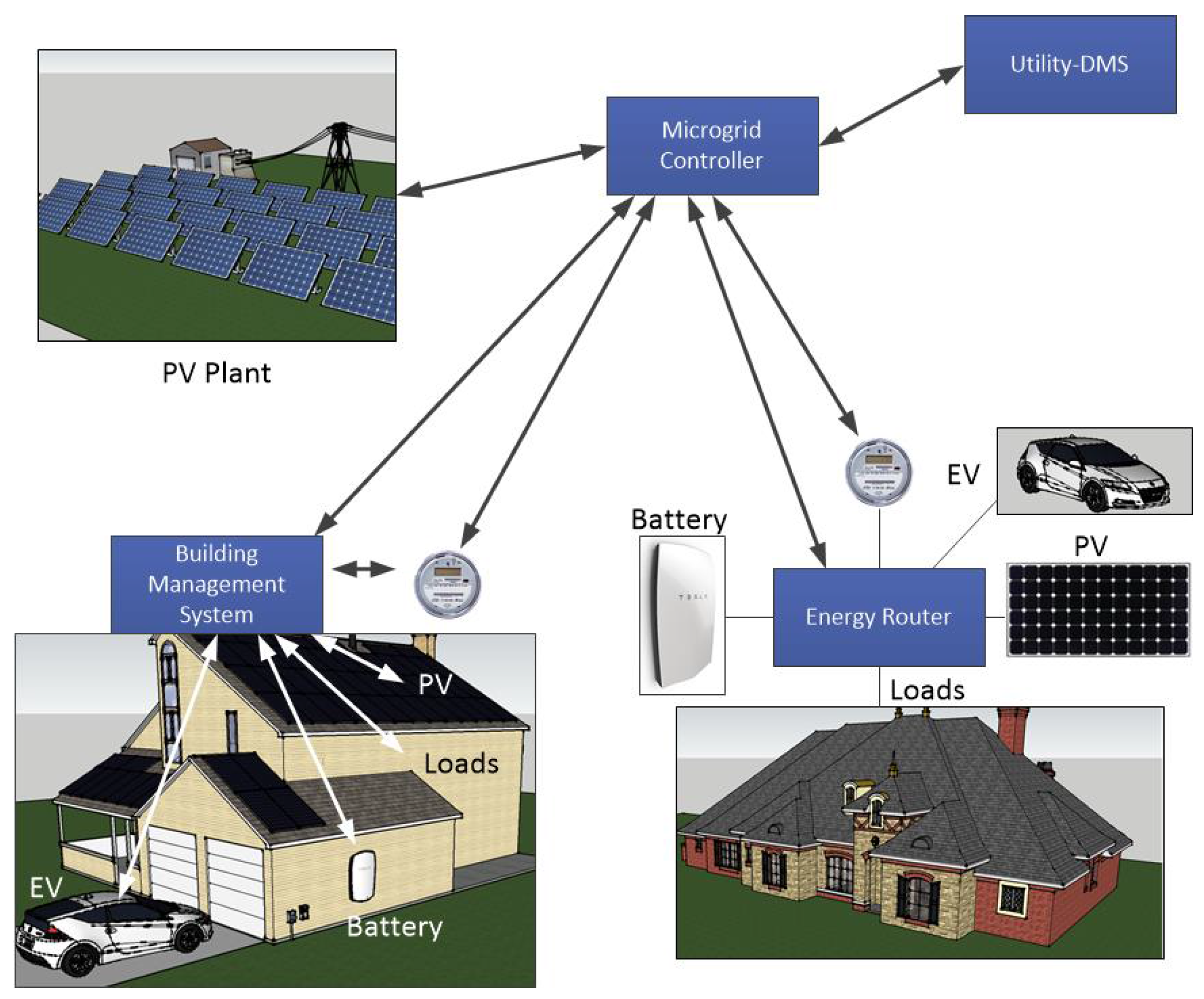

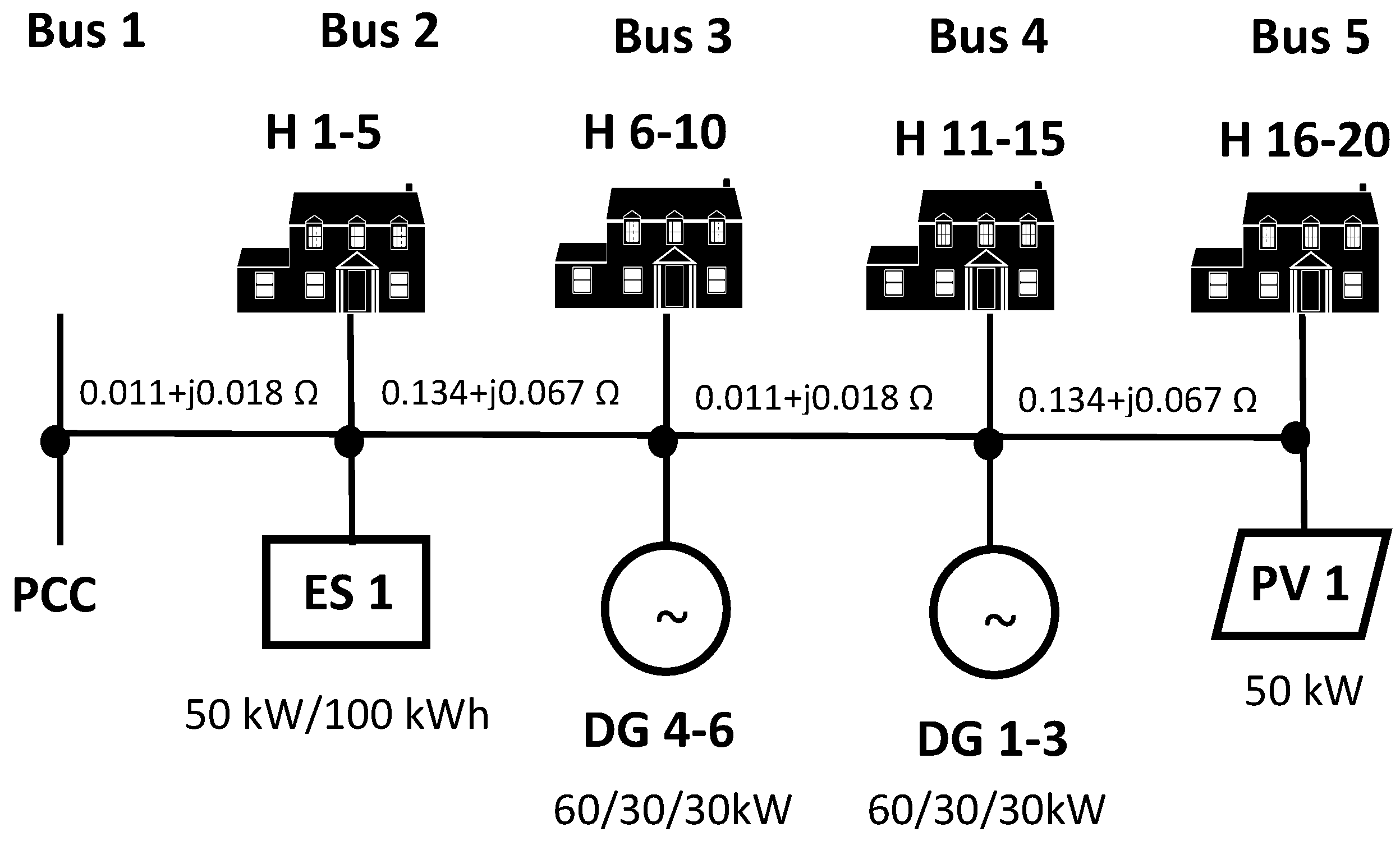
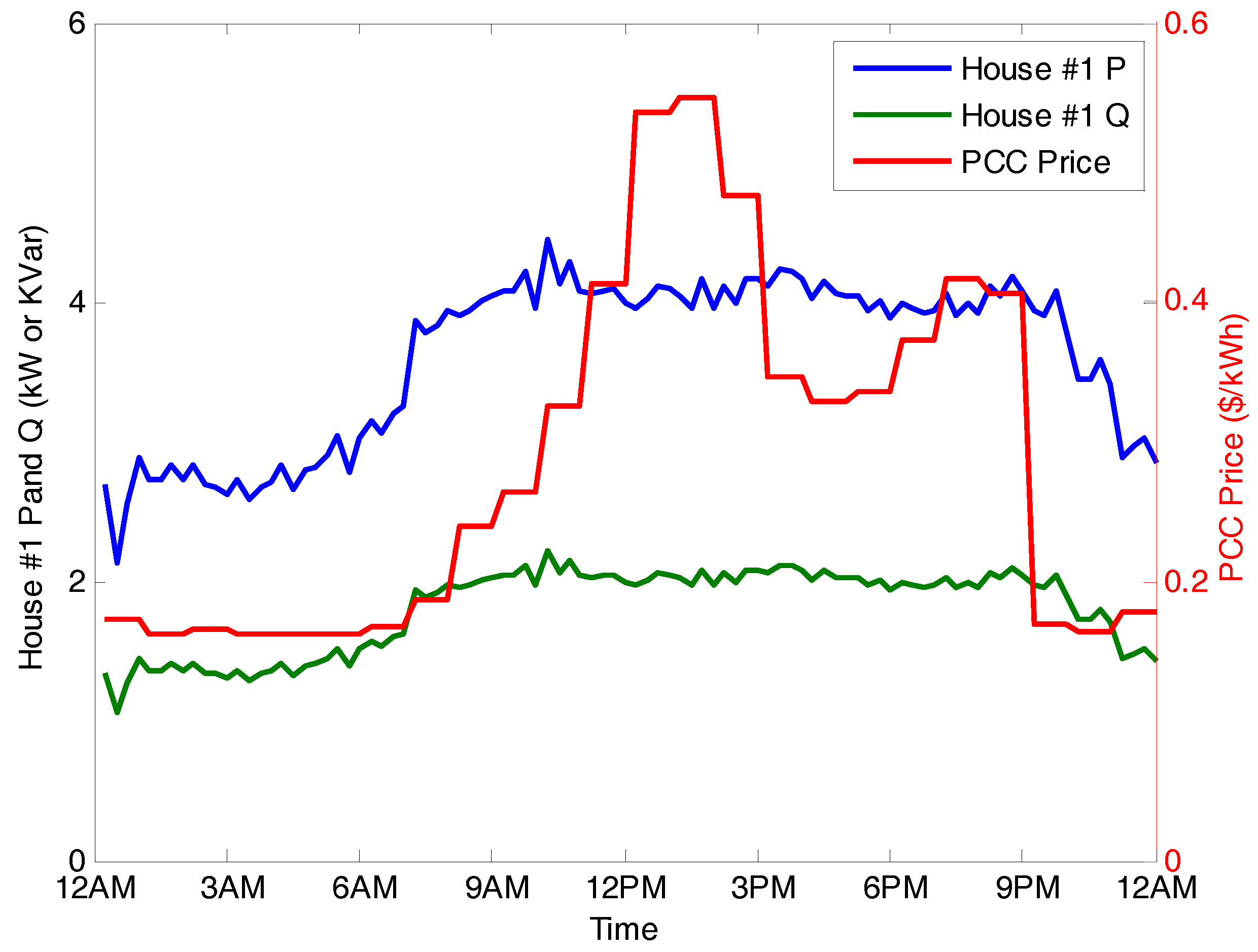

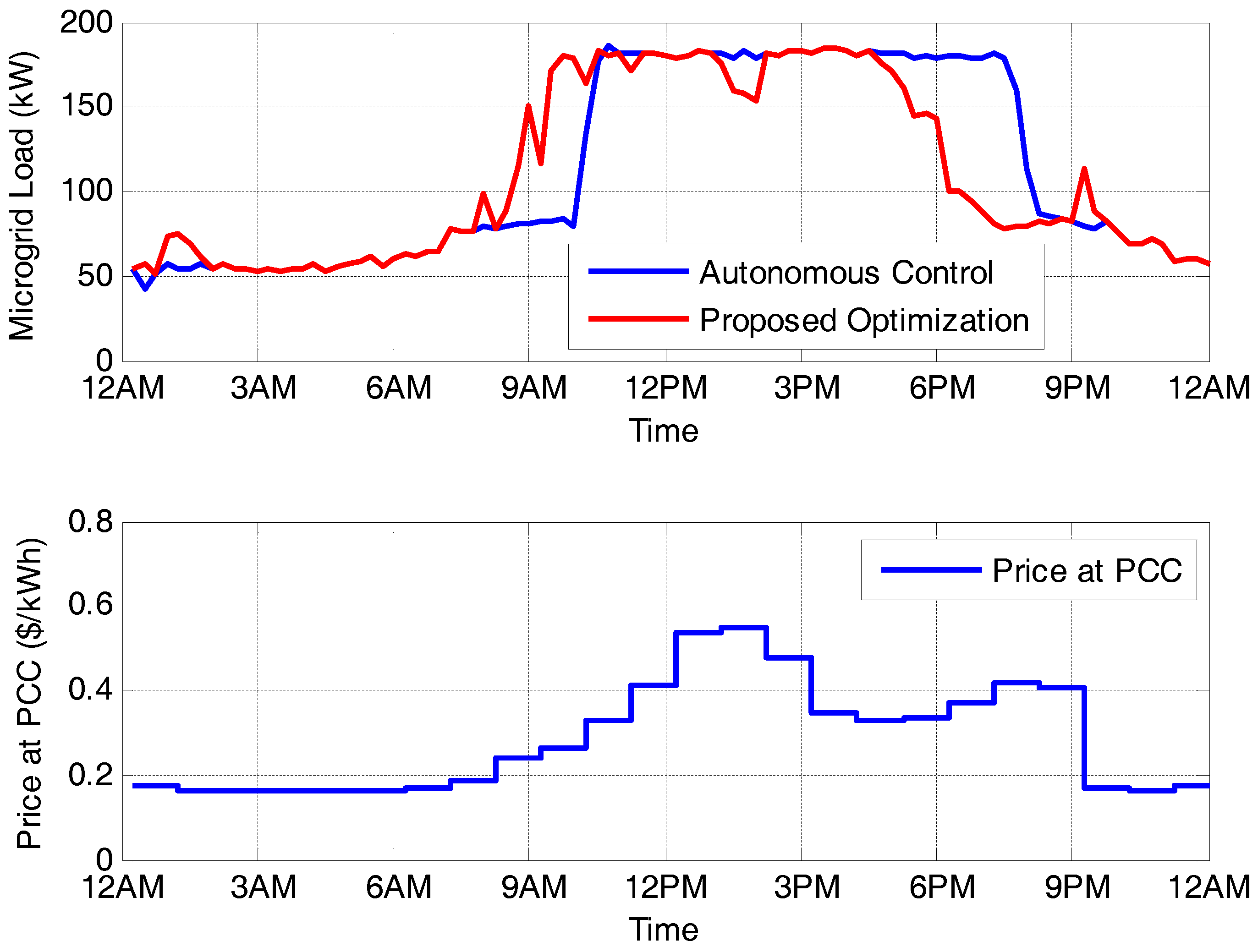
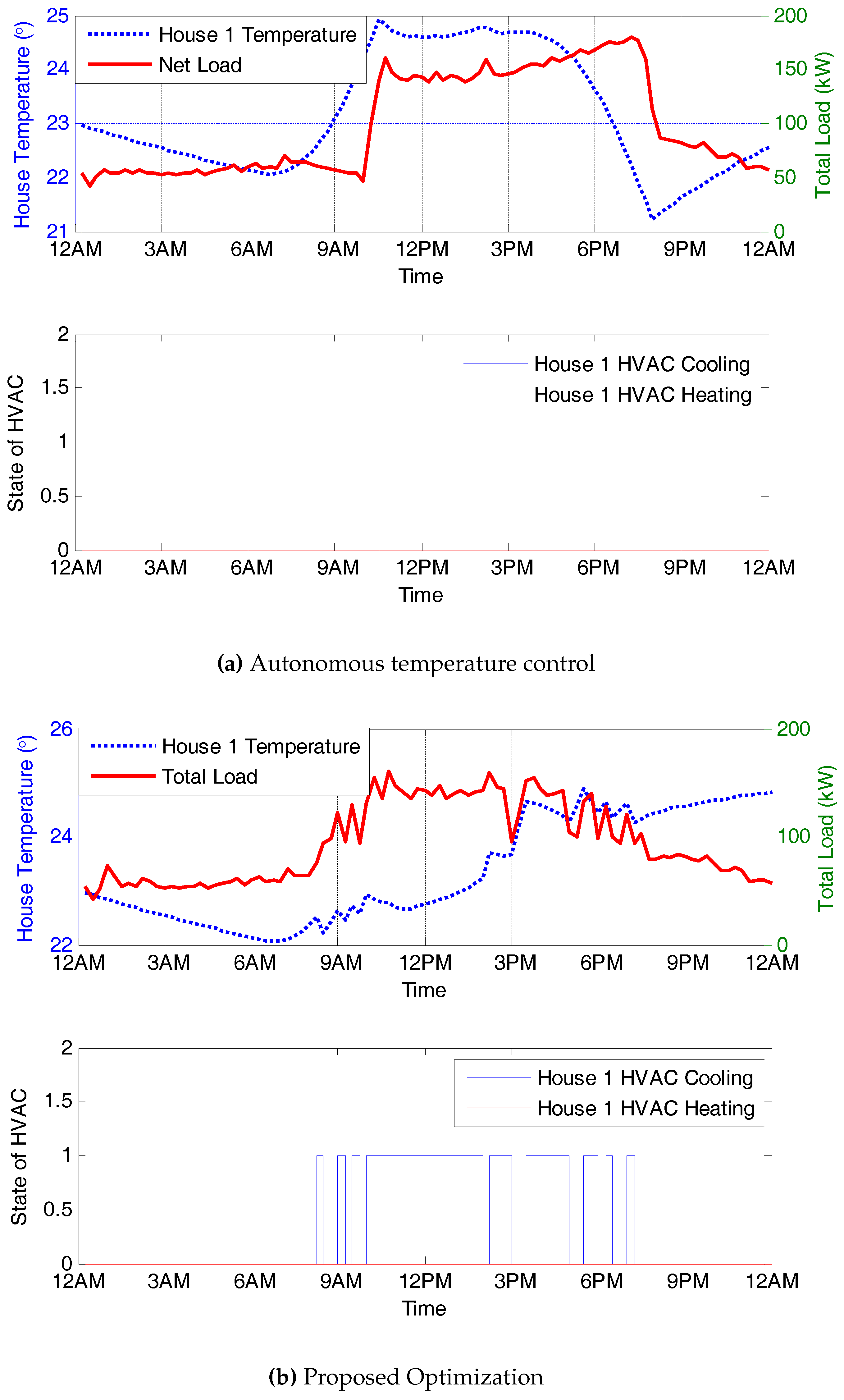
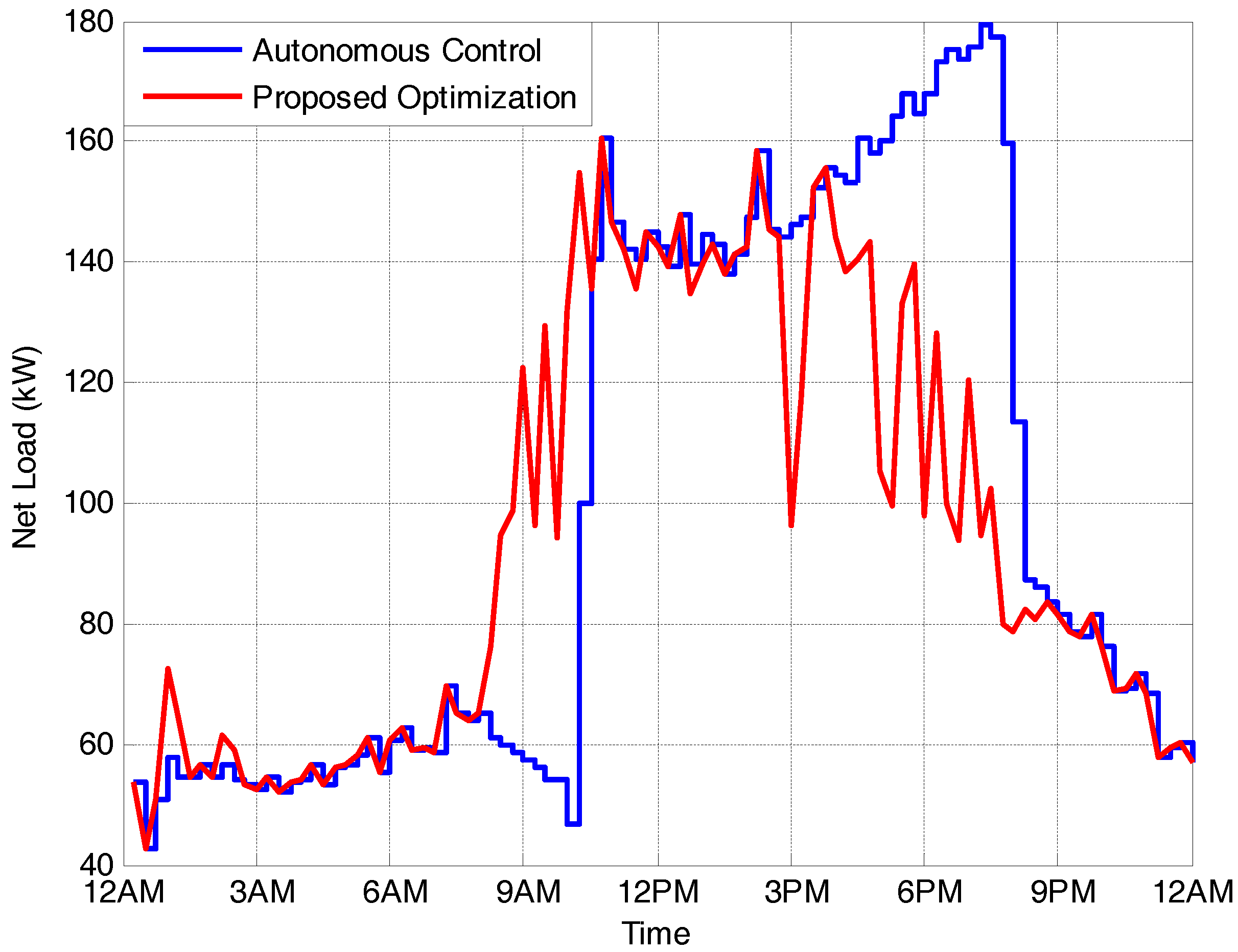
| Total Cost | Total Reactive Power | Voltage Deviation | Network Loss | |
|---|---|---|---|---|
| Total Cost | 1 | 2 | 1/3 | 3 |
| Total Reactive Power | 1/2 | 1 | 1/5 | 2 |
| Voltage Deviation | 3 | 5 | 1 | 10 |
| Network Loss | 1/3 | 1/2 | 1/10 | 1 |
| Single Objective Optimization | Multiobjective Optimization | Autonomous Control | ||||
|---|---|---|---|---|---|---|
| Optimizing Cost | Optimizing Loss | Optimizing Voltage | Optimizing Reactive Power | |||
| Total Cost ($) | 521.49 | 661.38 | 558.65 | 584.27 | 531.73 | 634.75 |
| Loss (kWh) | 51.95 | 5.8197 | 14.6587 | 35.8221 | 25.77 | 23.59 |
| Voltage Deviation (pu) | 6.12 | 0.24 | 0.016 | 11.63 | 2.06 | 1.45 |
| Reactive Power (KVARh) | 242.14 | 0.11 | 0.05 | 0 | 0.06 | 0.04 |
| Cases | Total Objective | Operating Cost ($) | Loss (kWh) | Voltage Deviation (pu) | Reactive Power (kVARh) | |
|---|---|---|---|---|---|---|
| Grid-connected | Case 1: Autonomous Control | 134.66 | 634.75 | 23.59 | 1.45 | 0.04 |
| Case 2: Proposed Optimization | 113.70 | 531.73 | 25.77 | 2.06 | 0.06 | |
| Islanded | Case 3: Autonomous Control | 148.60 | 693.62 | 24.99 | 3.00 | 5.49 |
| Case 4: Proposed Optimization | 128.64 | 601.06 | 20.42 | 2.30 | 5.86 | |
© 2017 by the authors. Licensee MDPI, Basel, Switzerland. This article is an open access article distributed under the terms and conditions of the Creative Commons Attribution (CC BY) license (http://creativecommons.org/licenses/by/4.0/).
Share and Cite
Liu, G.; Ollis, T.B.; Xiao, B.; Zhang, X.; Tomsovic, K. Community Microgrid Scheduling Considering Network Operational Constraints and Building Thermal Dynamics. Energies 2017, 10, 1554. https://doi.org/10.3390/en10101554
Liu G, Ollis TB, Xiao B, Zhang X, Tomsovic K. Community Microgrid Scheduling Considering Network Operational Constraints and Building Thermal Dynamics. Energies. 2017; 10(10):1554. https://doi.org/10.3390/en10101554
Chicago/Turabian StyleLiu, Guodong, Thomas B. Ollis, Bailu Xiao, Xiaohu Zhang, and Kevin Tomsovic. 2017. "Community Microgrid Scheduling Considering Network Operational Constraints and Building Thermal Dynamics" Energies 10, no. 10: 1554. https://doi.org/10.3390/en10101554





